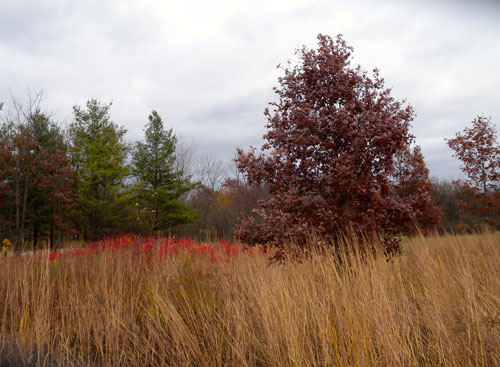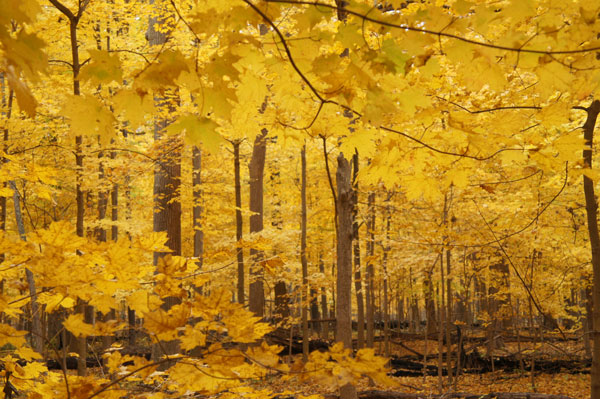September Wisdom from the Trees 2013
/Water, Ice, Dust and Fire!
A Story of Illinois Soil by Gilbert A Smith
ISA Certified Master Arborist
Fall Colors by Gilbert A SmithWhy is it that Illinois is called “The Prairie State” ? Why is our climax forest ‘Oak/Hickory‘ when just 50 miles east in Michigan the climax forest is ‘Beech/Maple’ and why do most of our trees grow 30% shorter than they do almost everywhere else: North, South, East, or West? Many texts say that our harsh climate inhibits the growth of many trees, (USDA zone map) but you are hearing it here first, THE REAL REASON IS THE SOIL. Illinois has a unique soil history that strongly impacts our gardens, our landscapes, our wonderful natural resources, our economy and our ecology.
So here is the story that you should have heard in kindergarten. A long, long time ago the Midwest was covered by an inland sea. Indeed the whole interior of the continent from Canada to Florida has a shallow bowl of bedrock formed of compacted sea sediment or limestone. This layer of bedrock is what Niagara Falls flows over, it’s what Door County, Wisconsin is made of, and it underlies Chicago. Slow moving underground rivers still flow along these bedrock lines from Montana to the Gulf of Mexico, so it is even the source of the springs in Arkansas and Florida. Incidentally that is why “fracking” to extract natural gas has to be done carefully so that the interconnected underground waterways are not polluted.
Now, fast forward to the ice ages.
Giant mountains of ice several miles thick excavated and pulverized the limestone bedrock into a very fine powder. Similar to baby powder, this dust called glacial loess was blown east by the prevailing westerly winds. Have you ever wondered why the landscape from Nebraska to Toledo, Ohio is so flat? This powdered sea shell dust created the great plains. It was blown in, think dust bowl, it settled and filled in all of the low spots. In Illinois, for example, near the Mississippi River the glacial loess can be 200 feet thick.
You can imagine that the pulverized marine sediment contains all of the available minerals that any plant would ever need to grow. This is the first reason that the Midwest is and could always be the bread basket of the world.
The dirty story continues...
Over time the fine, mineral rich powder was organized into clay colloids which is just a way of saying that in the presence of water and energy it got electro-chemically organized. No longer just dust, the clay developed its own distinct structure, so distinct in fact that it is close to what we call being “ALIVE”. By this I mean that the clay colloids arrange themselves in an almost exact replication of a DNA molecule. The implication here is that the clay colloids could have been the template for the very first DNA strand. Dust is the origin of life. Even the ancient creation stories tell us that life was made out of dust.
So, we have this vast, flat, mineral rich landscape in the center of the continent where warm moist air from the Gulf meets cold air from the North. What happens? It rains a lot. If the soil was rocky, sandy, or hilly as it is in most other places in the country, or the world, it would have washed away and taken with it all of those precious minerals. The tropical rain forests are an example. When the forests are slashed and burned the soil minerals are quickly washed out, the soil is used up and barren in a few years.
Not so in the Midwest. The clay, as everyone knows, does not allow fast water penetration and there are no valleys for the water to concentrate and flow away. So... the prairie state was actually the swampy state for much of the year before European settlers tiled and drained their fields. Just 4 generations ago in the spring of the 1800’s you could paddle a canoe 20 miles between Champaign and Rantoul, Illinois anywhere across the prairie without the need of looking for a river. This water logged soil made it difficult to grow crops and impossible for most trees because their roots drowned. But the prairie flourished.
Did you know that the prairies produce as much biomass per acre and sequester as much carbon from our environment as the tropical rain forests? In the presence of water logged soils however, the huge production of biomass (the dead leaves and stems that go dormant every winter) could not be broken down as fast as it would be in a well aerated soil. The breakdown of organic matter, or oxidation, in water logged soil is 8 times less efficient than in normal soils. Over 15,000 years the rich organic topsoil built up to unprecedented levels. Nowhere else in the world is the topsoil so deep as it was in your and my back yards, yet we allow urban sprawl to eat up such valuable farm soil.
The organic matter is the underlying reason why the soil is so black in Illinois, Indiana and Iowa. Have you ever looked at the soil in the Piney woods of Wisconsin? You’re lucky if you can find an inch of good dark topsoil since it has been broken down and washed away or taken up to build the trees. Or have you ever traveled further south in Illinois near Springfield where the soil turns red? There too, and throughout the South, indeed much of the rest of the world the soil is poor and depleted by comparison to the Prairie State.
Prairie Fire by Gilbert A SmithHold on, there is still one more interesting character in the story, FIRE. Every spring and fall when the grasses were dry the thunder storms started prairie fires. The strong westerly winds unobstructed by trees or mountains drove those fires into huge conflagrations traveling East. The Native Americans noticed that the fires made better grazing lands for buffalo, better growing lands for their crops, kept the trees out for security and they could use fire to heard and hunt animals. Any trees that didn’t have a thick, fire resistant bark, like Burr Oak or Shagbark Hickory, were eliminated. If you want to see the ghosts of the first land managers look in the Lake and Cook county forest preserves. You will notice if you go there during fall color season that the best trees for fall color, the Sugar Maples, don’t grow on the west side of the Des Plaines River. A natural fire break, the river protected the thin barked Sugar Maples on its east side.
Fall Colors in Ryerson Forest Preserve by Gilbert A SmithCome with me if you would like to enjoy a Saturday afternoon fall color walk through the “sugar bush” at Ryerson Forest Preserve in Riverwoods on Riverwoods Rd. on Oct 19th from 3:30 to 5PM. Meet at the South parking lot and I will explain why Sugar Maples here have yellow fall color when they exhibit red fall color in Vermont and Wisconsin. Hint: It has to do with seashells.
Stay tuned next month for the continuing drama of water, ice, dust and fire! The miracle of Midwest soil.









